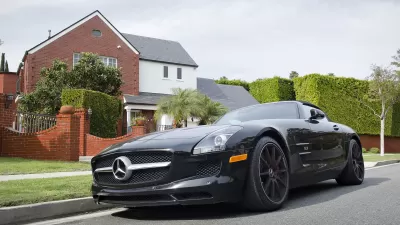Edward L. Glaeser takes the recent purchase of Zipcar by Avis as the jumping-off point for an essay on the ways that technology, which once aided the sprawling suburban lifestyle, can now amplify the sharing of infrastructure by city dwellers.
"Sharing most things is hard over long distances, and one of the great advantages of city living is the ability to share infrastructure, which lowers fixed costs and expands one’s options," writes Glaeser. With more and more people interested in partaking in the shared experiences of city living - from walkable streets to cohabiting hackerspaces - the sharing economy has developed to amplify the benefits and opportunities made possible by urban density. And, for Glaeser, this is a key departure from the ways that technology served the sprawling development patterns of the latter half of the 20th century.
"In the mid-20th century, revolutions in communication and transportation favored the suburbs. Radios, movies, and television brought entertainment with high production values — once an urban monopoly — into far-flung places. The car and the interstate highway system made it possible to live and work at far lower densities, away from urban public transportation."
"But today’s information technology is more about mastering detail than bridging distance, and that favors cities....All that detail makes coordination easier and bad behavior easier to catch, and that helps sharing."
"I don’t know if Avis will make money from its Zipcar purchase," concludes Glaeser, "but city dwellers throughout the world stand to benefit from the innovations that make it easier to share not just cars, but everything else."
FULL STORY: The urban innovation model

Planetizen Federal Action Tracker
A weekly monitor of how Trump’s orders and actions are impacting planners and planning in America.

Maui's Vacation Rental Debate Turns Ugly
Verbal attacks, misinformation campaigns and fistfights plague a high-stakes debate to convert thousands of vacation rentals into long-term housing.

Restaurant Patios Were a Pandemic Win — Why Were They so Hard to Keep?
Social distancing requirements and changes in travel patterns prompted cities to pilot new uses for street and sidewalk space. Then it got complicated.

Charlottesville Temporarily Has No Zoning Code
A judge ordered the Virginia city to throw out its newly revised zoning code, leaving permitting for new development in legal limbo.

In California Battle of Housing vs. Environment, Housing Just Won
A new state law significantly limits the power of CEQA, an environmental review law that served as a powerful tool for blocking new development.

Boulder Eliminates Parking Minimums Citywide
Officials estimate the cost of building a single underground parking space at up to $100,000.
Urban Design for Planners 1: Software Tools
This six-course series explores essential urban design concepts using open source software and equips planners with the tools they need to participate fully in the urban design process.
Planning for Universal Design
Learn the tools for implementing Universal Design in planning regulations.
Heyer Gruel & Associates PA
JM Goldson LLC
Custer County Colorado
City of Camden Redevelopment Agency
City of Astoria
Transportation Research & Education Center (TREC) at Portland State University
Jefferson Parish Government
Camden Redevelopment Agency
City of Claremont



























